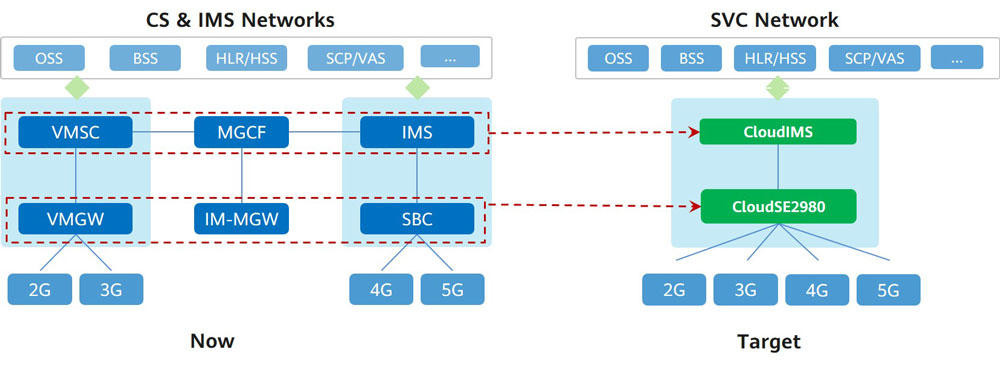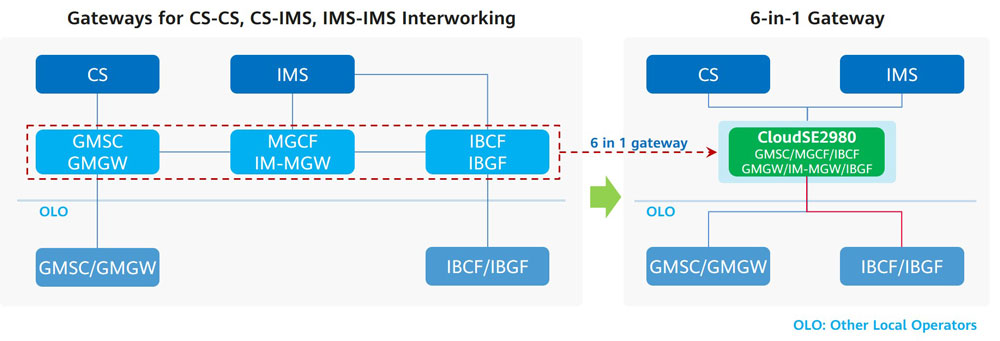Single Voice Core for an Agile, Efficient, All-in-One Voice Network
5G is becoming the new normal for telecom networks, but despite the new possibilities it brings, voice services are still indispensable. Global operators have been setting their attention on how to build a 5G-oriented voice network and improve voice service experience.
A Convergent Voice Network: the Inevitable
3GPP has introduced VoNR and EPS Fallback solutions for voice services in 5G. Both solutions use VoLTE as the foundation, and are currently in urgent demand to accelerate construction of VoLTE networks. Meanwhile, there still are a large number of 2G/3G and IoT terminals on live networks, so legacy 2G/3G voice networks will exist for a long time. If operators continue to use this siloed architecture in the construction of their 5G networks, they will have to invest in and operate several types of voice networks at once. This results in high O&M costs (such as for interface integration, troubleshooting, and upgrades) and a less-than-ideal return on investment. Operators have therefore called for a solution that can provide secure and reliable voice services, maximize the return on existing networks, and support smooth evolution to the 5G era.
Single Voice Core: an Agile, Efficient Voice Network
Huawei unveiled the all-cloud, all-in-one Single Voice Core (SVC) solution to cope with the preceding issues. This solution adopts the Service Domain Centralization in IMS (SeDoC) architecture defined in 3GPP TS 23.292. An SVC network integrates CS and IMS services and provides voice services for 2G, 3G, 4G, 5G, and fixed-line subscribers

Figure 1 Architecture of the Single Voice Core solution
Huawei Single Voice Core solution offers convergent end office and gateway office capabilities.
Convergent End Office
A convergent end office allows 2G/3G subscribers to register with the IMS network without retrofitting IP-based interfaces on the 2G/3G radio networks, boosting CS and IMS service integration.

Figure 2 Legacy end offices VS. Convergent end offices
- Convergent Network Access
- Convergent Session Control: The protocol-compliant CSCF controls sessions and manages routes for 2G/3G/4G/5G/fixed-line subscribers.
- Convergent Service Processing: The protocol-compliant telephony application server processes services for 2G/3G/4G/5G/fixed-line subscribers.
- The all-in-one voice network is orientated to 5G, accelerates CS retirement, and simplifies the network structure.
- Calls traversing an SVC network bypass the MGCF and share NFVI resources, reducing the investment in hardware by 20%-30% and maximizing return on investment.
- An SVC network requires fewer NEs and external interfaces, improving O&M efficiency.
- The SVC network adopts the Cloud Native architecture, inspiring service innovation and accelerating service rollout. In addition, an SVC network opens APIs to provide audio & video capabilities for third-party applications.
Convergent signaling access: The protocol-compliant mAGCF and P-CSCF exchange signaling with 2G/3G/4G/5G/fixed-line subscribers to allow these subscribers to register with the IMS network.
Converged media plane: The protocol-compliant MGW and A-SBC processes media for 2G/3G/4G/5G/fixed-line subscribers.
Convergent Gateway Office
The Single Voice Core solution uses the CloudSE2980 to provide all-in-one, full-cloud IP gateway capabilities, simplifying gateway office networking.

Figure 3 Legacy gateway offices VS. Convergent gateway offices
In conclusion, Huawei Single Voice Core solution brings the following benefits:
So far, most operators have reached a consensus to construct networks that can integrate 2G, 3G, 4G, and 5G voice services in one. We firmly believe that the Huawei Single Voice Core solution will help operators integrate voice networks, boost new voice services, improve operation efficiency, and create business value.